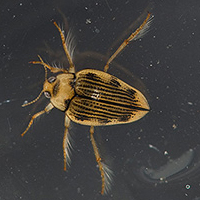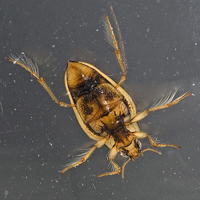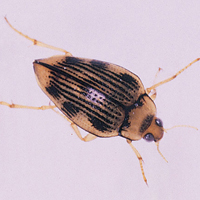Hungerford’s crawling water beetle
Scientific name: Brychius hungerfordi



Cover photos credit: Steve Marshall (all photos)
Status
Endangered
“Endangered” means the species lives in the wild in Ontario but is facing imminent extinction or extirpation.
Date added to the Species at Risk in Ontario List
January 13, 2012.
Read the Assessment Report
What it looks like
As an adult, Hungerford’s Crawling Water Beetle is a small yellowish-brown insect, about four millimetres long, with irregular dark stripes on its back.
These beetles have four life stages: egg, larva, pupa and adult. Adult beetles may live for up to 18 months.
Where it lives
This beetle is found in small to medium-sized streams with cool, high quality, fast-flowing water, often immediately downstream from beaver dams, culverts and man-made barriers.
As larvae, they may require a specific kind of algae (Dichotomosiphon) to eat.
Where it’s been found in Ontario
In Ontario, this beetle’s range is restricted to three rivers in Bruce County. It has also been found in five rivers in northern Michigan. These are the only places in the world where this beetle is found.
View a Larger version of this map (PDF)
What threatens it
Threats to this beetle are believed to include activities that harm its habitat, such as agricultural practices that degrade water quality, alterations to stream flow, and beaver control and dam removal.
The beetle may also be preyed on by introduced fish such as brown trout.
Action we are taking
Endangered Species and their general habitat are automatically protected.
Recovery strategy
A recovery strategy advises the ministry on ways to ensure healthy numbers of the species return to Ontario.
Read the executive summary (January 11, 2013)
Read the recovery strategy (January 11, 2013)
Government response statement
A government response statement outlines the actions the government intends to take or support to help recover the species.
Read the government response statement (October 11, 2013)
Five-year review of progress
A five-year review of progress made toward protecting and recovering a species is required no later than five years after the government response statement for that species is published.
Read the report on progress towards the protection and recovery of 17 species at risk, including the Hungerford’s Crawling Water Beetle (2018).
Habitat protection
A habitat regulation defines a species’ habitat and may describe features (e.g., a creek, cliff, or beach), geographic boundaries or other unique characteristics.
Read the habitat summary (January 1, 2015)
Read the regulation (January 1, 2015)
What you can do
Report a Sighting
Report a sighting of an endangered animal or plant to the Natural Heritage Information Centre. Photographs with specific locations or mapping coordinates are always helpful.
Learn more about reporting wildlife.
Volunteer
Volunteer with your local nature club or provincial park to participate in surveys or stewardship work focused on species at risk.
Be a good steward
Private land owners have a very important role to play in species recovery. If you find Hungerford’s Crawling Water Beetle on your land, you may be eligible for stewardship programs that support the protection and recovery of species at risk and their habitats.
Report illegal activity
Report any illegal activity related to plants and wildlife to
Quick facts
- a globally rare species, this beetle was first documented in Canada in 1986
- this beetle is likely a “glacial relict,” a species that survived from the ice age in an isolated habitat
